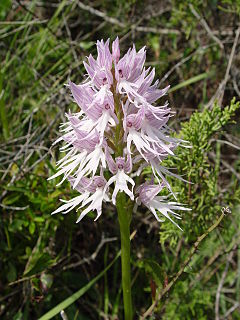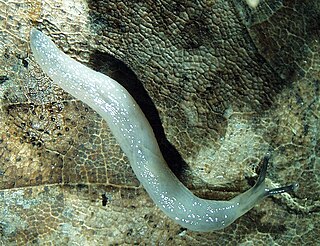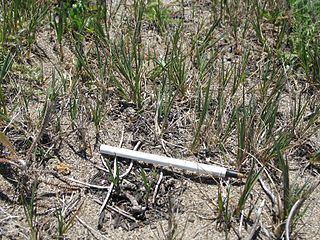
Calliandra is a genus of flowering plants in the pea family, Fabaceae, in the mimosoid clade of the subfamily Caesalpinioideae. It contains about 140 species that are native to tropical and subtropical regions of the Americas.

Orchis is a genus in the orchid family (Orchidaceae), occurring mainly in Europe and Northwest Africa, and ranging as far as Tibet, Mongolia, and Xinjiang. The name is from the Ancient Greek ὄρχις orchis, meaning "testicle", from the appearance of the paired subterranean tuberoids.
Condé Benoist Pallen was an American Catholic editor and author.
The amethyst dancer is a damselfly of the family Coenagrionidae, native from southwestern North America south to Guatemala.
The Panda's Thumb is a blog on the creation–evolution controversy from a mainstream scientific perspective. In 2006, Nature listed it as one of the top five science blogs, and Mark Pallen has called it "the definitive blog on the evolution versus creationism debate".

The mangrove vireo is a species of bird in the family Vireonidae.

Boettgerilla pallens, common name the worm slug, is a European species of air-breathing land slug, a terrestrial pulmonate gastropod mollusk in the family Boettgerillidae.

Agrostis pallens is a species of grass known by the common name seashore bent grass. It is native to western North America from British Columbia to Montana to California, where it grows in many types of habitat, typically open meadows, woodlands, subalpine areas, and other dry habitats. The diploid number of the grass is either 42 or 56.

Phalaenopsis pallens is an endemic species of orchid from the Philippines.
Purum is a Kuki-Chin language of India. However, speakers consider themselves to be ethnic Naga people, rather than part of the Kuki and Chin ethnic groups. Peterson (2017) classifies Purum as part of the Northwestern branch of Kuki-Chin. According Ethnologue, Purum shares a high degree of mutual intelligibility with Kharam.
Moses Montrose Pallen was an American physician, obstetrician, educator and writer.

Allium pallens is a species of wild onion native to the Mediterranean region and Middle East from Portugal and Algeria to Iran.

The Central American paper wasp is a nocturnal eusocial wasp. It is famous for its swarm based emigration behavior, and is native to the lowlands of Central and northern South America. This species has developed special night vision adaptations to facilitate their night-time swarming and forging behavior and has important medicinal properties for the Pankarare ́ people of Brazil.

Sybra is a genus of beetles in the family Cerambycidae, containing the following species:

Sybra umbratica is a species of beetle in the family Cerambycidae. It was described by Pascoe in 1865.
Sybra uenoi is a species of beetle in the family Cerambycidae. It was described by Hayashi in 1956. It is known from Japan.
Sybra bioculata is a species of beetle in the family Cerambycidae. It was described by Pic in 1925. It contains four subspecies: Sybra bioculata bioculata, Sybra bioculata quadrinotata, Sybra bioculata sikkimana, and Sybra bioculata tigrina.

Sybra ordinata is a species of beetle in the family Cerambycidae. It was described by Bates in 1873.
Sybra pascoei is a species of beetle in the family Cerambycidae. It was described by Lameere in 1893.
Sybra subfasciata is a species of beetle in the family Cerambycidae. It was described by Bates in 1884.












